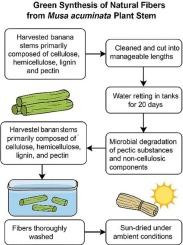Sustainable isolation and characterization of natural fibers from Musa acuminata stem for green composite development
IF 4.2
Q2 CHEMISTRY, MULTIDISCIPLINARY
引用次数: 0
Abstract
This study reports the sustainable extraction and characterization of natural fibers from Musa acuminata stems, emphasizing their role as eco-friendly reinforcements for green composites in line with global sustainability goals. Over 100 million tonnes of banana biomass are generated annually worldwide, much of which is discarded, posing environmental challenges. Converting this residue into value-added fibers supports circular bioeconomy strategies and meets the growing demand for natural fiber composites. Fibers were isolated using an environmentally benign retting process and assessed for antibacterial, anti-biofilm, mechanical, thermal, and morphological properties. Antibacterial assays against Escherichia coli showed notable activity, with 100 μg extract producing a 21 mm inhibition zone comparable to streptomycin (23 mm), while 25 μg yielded 9 mm. Confocal Laser Scanning Microscopy confirmed biofilm disruption through strong propidium iodide staining. Mechanical testing revealed a tensile strength of 23.76 MPa at 0.32 strain, reflecting favorable ductility and strength. Thermogravimetric analysis indicated a primary degradation peak at 386.37 °C with 43.72 % mass loss, confirming thermal stability for polymer processing. Scanning Electron Microscopy showed fibrillated surfaces with microvoids and partial delamination, promoting interfacial adhesion in composites. These combined properties demonstrate Musa acuminata fiber as a renewable candidate for biomedical, packaging, and structural applications, advancing the global transition toward eco-friendly materials.

面向绿色复合材料开发的木芋茎中天然纤维的可持续分离与表征
本研究报告了从Musa acuminata茎中提取的天然纤维的可持续提取和表征,强调了它们作为符合全球可持续发展目标的绿色复合材料的环保增强材料的作用。全世界每年生产的香蕉生物量超过1亿吨,其中大部分被丢弃,构成了环境挑战。将这种残留物转化为增值纤维支持循环生物经济战略,并满足对天然纤维复合材料日益增长的需求。使用环境友好的固化工艺分离纤维,并评估其抗菌、抗生物膜、机械、热学和形态特性。对大肠杆菌的抑菌活性显著,100 μg提取物产生21 mm的抑制带,与链霉素(23 mm)相当,而25 μg提取物产生9 mm的抑制带。共聚焦激光扫描显微镜通过强碘化丙啶染色证实生物膜破坏。力学试验结果表明,在0.32应变下,其抗拉强度为23.76 MPa,具有良好的延性和强度。热重分析表明,初始降解峰在386.37℃,质量损失43.72%,证实了聚合物加工的热稳定性。扫描电镜显示纤维化表面带有微孔和部分分层,促进了复合材料的界面粘附。这些综合性能证明了Musa acuminata纤维作为生物医学、包装和结构应用的可再生候选材料,推动了全球向环保材料的过渡。
本文章由计算机程序翻译,如有差异,请以英文原文为准。
求助全文
约1分钟内获得全文
求助全文

 求助内容:
求助内容: 应助结果提醒方式:
应助结果提醒方式:


